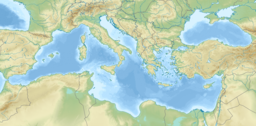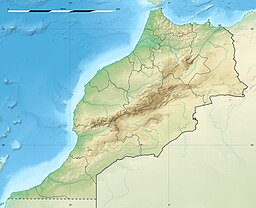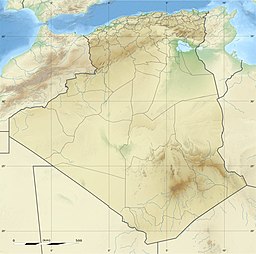Alboran Sea
| Alboran Sea | |
|---|---|
| Mar de Alborán | |
 | |
| Location | Southern EuropeandNorth Africa |
| Coordinates | 36°0′N3°0′W/ 36.000°N 3.000°W |
| River sources | Guadalhorce River,Guadalfeo River,Adra River (Spain) and Nekor River (Morocco) |
| Ocean/sea sources | Atlantic Ocean |
| Basincountries | Algeria,Gibraltar(UK),Morocco,andSpain |
| Average depth | 445 metres (1,460 ft) |
| Max. depth | 1,500 metres (4,900 ft) |
| Settlements | Málaga,Marbella,Motril,AlmeríaandCartagena,Spain AlhucemasandNador,Morocco,Gibraltar |
TheAlboran Seais the westernmost portion of theMediterranean Sea,lying between theIberian Peninsulaand the north ofAfrica(Spain on the north and Morocco and Algeria on the south). TheStrait of Gibraltar,which lies at the west end of the Alboran Sea, connects the Mediterranean with theAtlantic Ocean.
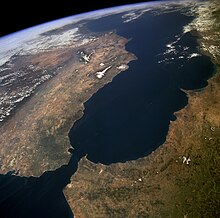
Geography
[edit]Its average depth is 445 metres (1,460 ft) and maximum depth is 1,500 metres (4,900 ft).
TheInternational Hydrographic Organizationdefines the limits of the Alboran Sea as follows:[1]
On the West.The Eastern limit of the Strait of Gibraltar: A line joining from tip (Europa Point) ofCap Gibraltarin Europe to the tip of thePenínsula de AlminaofCeutain Africa (35°54′N5°18′W/ 35.900°N 5.300°W).
On the East.A line joining fromCabo de GatainAndalusiain Europe toCap Fegalo,nearOran, Algeriain Africa (35°36′N1°12′W/ 35.600°N 1.200°W).
Several small islands dot the sea, including the eponymousIsla de Alborán.Most, even those close to the African shore, belong to Spain.
Geology
[edit]The Alboran domain, the seafloor beneath the Alboran Sea (known as the internal zones) together with the surrounding mountains (known as the external zones; theGibraltar ArcandAtlas Mountains), is mostly made ofcontinental crustand marks the westernmost terminus of theterranesthat were subducted between theAfricanandEurasian Plateswhen theTethys Oceanclosed. Reoccurring earthquakes at a depth of about 600 km (370 mi) indicate that thissubductionis ongoing and that complex interactions between thelithosphereand mantle are forming the region.[2]The internal zones are made of Late Paleozoic toTriassicrocks that were piled up during the Tertiary and has been extended since the EarlyMiocene.[3]
The seafloor is morphologically complex with several sub-basins, including three main sub-basins named West, East, and South Alboran Basins, ridges, and seamounts. The most prominent structure in the Alboran Sea is the 180 km long (110 mi) Alboran Ridge which stretches southwest from the volcanic Alborán Island.[4]
Oceanography
[edit]Surface currents in the Alboran Sea, influenced by the prevailing winds, flow eastward, bringing water from the Atlantic into the Mediterranean; deeper subsurface currents flow westward, carrying saltier Mediterranean water over the Gibraltar sill into the Atlantic. Thus there is typically a vertical rotary circulation, also known as agyre,in the Alboran Sea as a result of this exchange of water.[5]
Ecology
[edit]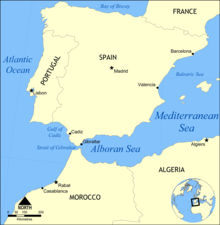
The Alboran Sea is a transition zone between ocean and sea, containing a mix of Mediterranean and Atlantic species. The Alboran Sea is habitat for the largest population ofbottlenose dolphinsand the last population ofharbour porpoisesin the western Mediterranean, and is the most important feeding grounds forloggerhead sea turtlesin Europe. The Alboran sea also hosts importantcommercial fisheries,includingsardinesandswordfish.In 2003, theWorld Wildlife Fundraised concerns about the widespreaddrift netfishing endangering populations of dolphins, turtles, as well as other marine animals. In 2023, the European Union, Morocco, and Algeria agreed to ban bottom fishing practices around Cabliers Bank, protecting the only cold-water coral reef known to be growing in the Mediterranean.[6]
An arc of mountains, known as theGibraltar Arc,wraps around the northern, western and southern sides of the Alboran Sea. The Gibraltar Arc is made up of theBaetic Cordilleraof Southern Spain and theRif Mountainsof Morocco. These mountains, known to ecologists as the Baetic-Rifan complex, comprise one of the Mediterranean'sbiodiversity hotspots;like the Alboran Sea, the Baetic-Rifan complex represents a transition between the Mediterranean and Atlantic (Macaronesian) ecological zones. The moderating influence of the Atlantic has allowed manyrelictspecies in the Baetic and Rif mountains to survive the climatic fluctuations of the last few million years that have caused them to become extinct elsewhere around the Mediterranean basin.
Islands
[edit]There are some small islands in the sea:[7]
References
[edit]Notes
[edit]- ^"Limits of Oceans and Seas, 3rd edition"(PDF).International Hydrographic Organization. 1953. Archived fromthe original(PDF)on 8 October 2011.Retrieved28 December2020.
- ^Alpert et al. 2013,Introduction, pp. 4265–4266.
- ^Iribarren et al. 2007,Introduction, p. 98.
- ^Comas et al. 1999,p. 559.
- ^C. Michael Hogan. 2011."Alboran Sea" in. eds. P. Saundry & C. J. Cleveland.Encyclopedia of Earth.(National Council for Science and the Environment) Washington DC
- ^"Mediterranean countries unite to protect unique deep-sea coral from fishing impacts".europe.oceana.org.Retrieved2023-11-17.
- ^"Map of Alboran Sea - Alboran Sea Map, World Seas, Alboran Location - World Atlas".www.worldatlas.com.Retrieved2017-10-12.
- ^"Alboran Sea - a sea in Atlantic Ocean".www.deepseawaters.com.Retrieved2017-10-12.
Sources
[edit]- Alpert, L. A.; Miller, M. S.; Becker, T. W.; Allam, A. A. (2013)."Structure beneath the Alboran from geodynamic flow models and seismic anisotropy"(PDF).Journal of Geophysical Research: Solid Earth.118(8): 4265–4277.doi:10.1002/jgrb.50309.Retrieved7 November2015.
- Comas, M. C.; Platt, J. P.; Soto, J. I.; Watts, A. B. (1999)."44. The origin and tectonic history of the Alboran Basin: insights from Leg 161 results".Proceedings of the Ocean Drilling Program Scientific Results.Vol. 161. pp. 555–580.Retrieved25 October2015.
- Iribarren, L.; Vergés, J.; Camurri, F.; Fullea, J.; Fernandez, M. (2007)."The structure of the Atlantic–Mediterranean transition zone from the Alboran Sea to the Horseshoe Abyssal Plain (Iberia–Africa plate boundary)".Marine Geology.243(1): 97–119.doi:10.1016/j.margeo.2007.05.011.Retrieved7 November2015.

